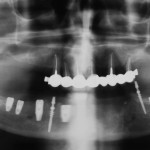
Peri-implantitis is a common reason for the failure of dental implants and a number of different treatments for managing this condition have been suggested (Dental Elf 26th Jan 2012). The aim of this review was to assess whether laser therapy was effective either as a monotherapy or as an adjunctive therapy in the treatment of peri-implantitis.
Searches were conducted in PubMed, Embase and the Cochrane Central Register of Controlled Trials (CENTRAL) databases. This was supplemented by searches in a ranged of relevant dental journals. Prospective controlled clinical studies conducted in humans that used laser therapy as monotherapy or as an adjunct in the treatment of peri-implantitis and reported data from at least 10 patients and had at lest 6-months follow up were considered. Peri-implantitis was defined as the presence of inflammation of the mucosa and loss of supporting bone around an implant in function. The primary outcomes were clinical attachment level gain (CAL) and the reduction in probing depth (PD). Two reviewers carried out study selection and data abstraction independently. Study quality was assessed using criteria based on the CONSORT statement.
- 6 studies (5 randomised controlled trials [RCTs], 1 controlled trial) were included.
- 3 were considered to be at high risk of bias, 1 moderate and 2 low risk of bias.
- 4 publications reported on results of Er:YAG treatment using a 2,940 nm wavelength ; 1 on CO2 laser treatment and 1 on photodynamic therapy
- Narrative synthesis of the results revealed that non-surgical laser treatment with a single application of either an Er:YAG (2,940 nm) laser, or a diode laser (660 nm) in combination with a phenothiazine chloride dye is efficient in controlling inflammation around treated implants for at least 6-months following intervention, while it only has a mild effect on reduction in probing depth (PD) and gain in clinical attachment level (CAL).
- A meta-analysis for the efficacy of Er:YAG laser did not reveal statistically significant evidence for treatment effects in reducing PD and CAL levels in comparison to controls.
The authors concluded
based on the limited currently available information any superiority of laser treatment in comparison to conventional treatment of peri-implantitis could not be identified.
Comment
The review which follows a sound methodology only focuses on the use of implants for the treatment of peri-implantitis. A Cochrane review (Dental Elf 26th Jan 2012) looked more broadly at treatments for peri-implantitis. They included 15 RCTs some of which used laser therapies. They concluded:-
There is no reliable evidence suggesting which could be the most effective interventions for treating peri-implantitis. This is not to say that currently used interventions are not effective.
This review did not find any more conclusive evidence for the effectiveness of lasers so more work is needed to identify the best way of managing peri-implantitis.
Links
Kotsakis GA, Konstantinidis I, Karoussis IK, Ma X, Chu H. A Systematic Review and Meta-Analysis of the Effect of Various Laser Wavelengths in the Treatment of Peri-Implantitis. J Periodontol. 2014 Jan 20. [Epub ahead of print] PubMed PMID: 24444398.
Dental Elf – 17th Feb 2014 – Limited evidence for surgical treatments for peri-implantitis
